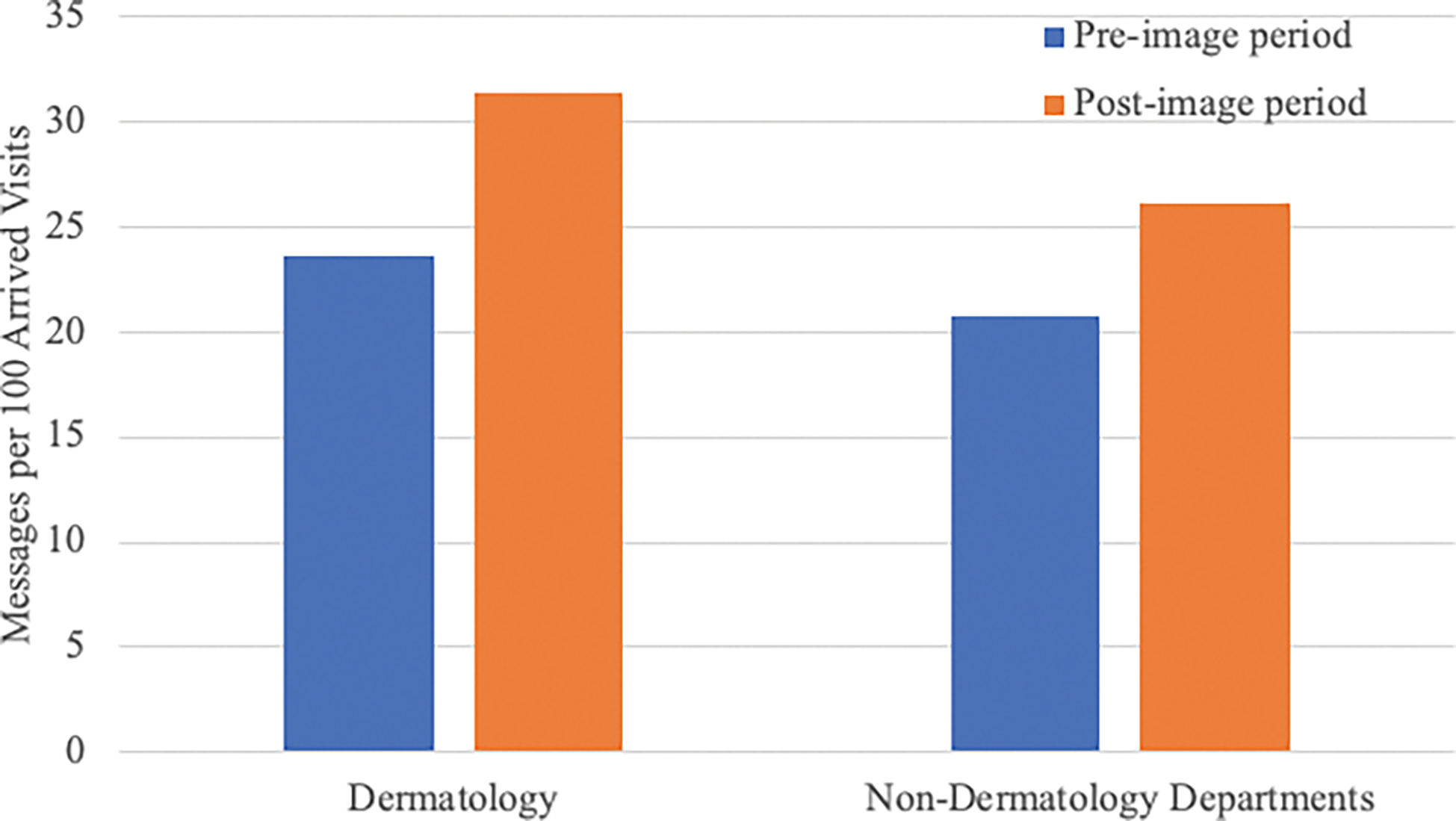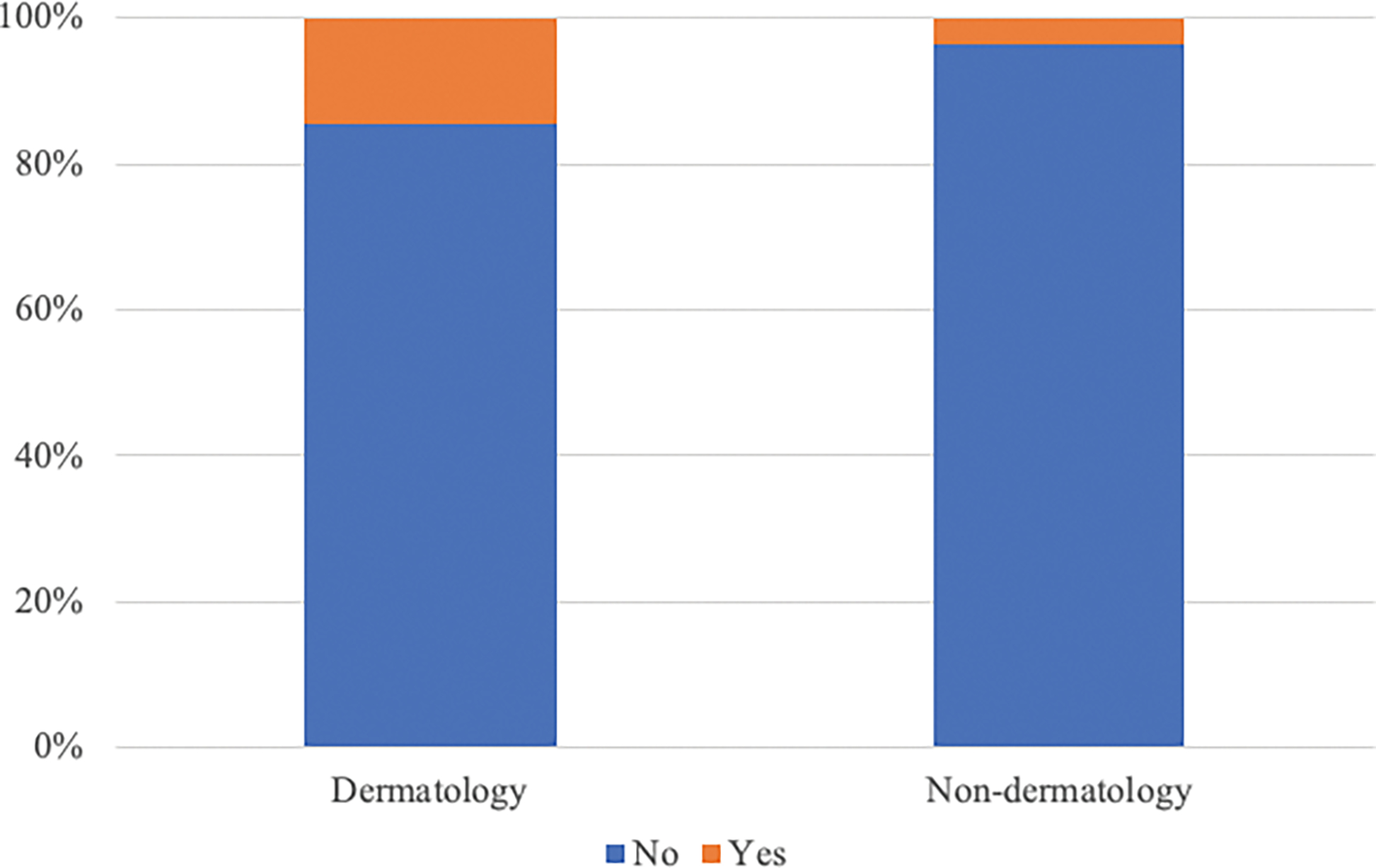LETTER
Clinicians face an increasing burden of electronic health record (EHR) notifications (1). Dermatologists may receive 50 EHR messages/day, associated with increasing burn-out symptoms (2). Recently, health systems have enabled patients to send unsolicited images to their physicians within patient-generated messages (PGMs). While patient-generated images may reduce overtreatment of surgical site infections, to our knowledge no study has evaluated the role of patient-generated images in dermatology (3). We sought to characterize the burden of patient-generated imaging sent to Duke University Health System (DUHS) and Duke Dermatology in 2017–2019.
We retrieved EHR logs of PGMs sent to DUHS from 08/21/2017–08/20/2018, before attachment functionality (pre-image period), and 08/21/2018–08/20/2019, after attachments were enabled (post-image period). We used chi-square tests to compare image message burden, the Wilcoxon rank sum test to compare reply time, a paired t-test for mean burn-out scores, and considered p<0.05 significant, assuming that each message was an independent observation. We distributed a survey on message behavior and burnout in 2017 and 2021 adapted from the validated Maslach Burnout Inventory (4, 5).
In total, 1,056,169 and 1,346,444 PGMs were sent in the pre-image and post-image periods, including 14,079 and 19,450 messages sent to dermatology. PGMs increased in the post-image periods by 5.4 messages/100 arrived visits in non-dermatology departments, and 7.8 messages/100 arrived visits in dermatology (Figure 1). The proportion of messages in the post-image period with image attachments was significantly higher in dermatology (n=2,797, 14.4%) than in non-dermatology departments (n=45,444, 3.4%; Figure 2; p<0.05). In Duke Dermatology, message reply times were significantly shorter in the post-image period (median=13.3 hours, IQR=2.3–28.9 hours) than in the pre-image period (median=16.5 hours, IQR=2.7–43.5 hours; p<0.05).
Figure 1:

Received Messages per 100 Arrived Visits in Dermatology and Non-Dermatology Departments
Figure 2.

Proportion of patient generated messages with picture attachments
Seventy-seven percent (n=27) of clinicians responded to the 2021 survey (Appendix 1). Almost all clinicians (93%) agreed that EHR messages benefit patient communication, however, only 44% of clinicians agreed that attachments benefit patient care. Clinicians also reported that messages with images increased workload (mean=3.4/4, range: strongly disagree to strongly agree). Compared to an identical burnout survey distributed in 2017, mean burnout scores for all clinicians were not significantly different, however, for eight clinicians with responses in 2017 and 2021, burnout scores (range=10 to 50) increased from a mean of 32 to 39 (p<0.05).
We analyzed over two million PGMs sent to Duke University Health System between 2017–2019. PGMs per arrived visit increased in all departments, but Duke Dermatology bore a disproportionate burden of PGMs with attachments, resulting in a high level of uncompensated work. Assuming reimbursement of $40/image, the first year post go-live resulted in a revenue loss of $112,000. Given this burden, dermatology departments should be involved in health system decision making around image messaging. Additionally, messages with images may take more clinician time to address, with complicated medical decision making, and there is little evidence as to their clinical utility. Taken together, these issues likely contribute to increasing clinician fatigue and burn-out. Further research must address the clinical utility of PGMs with image attachments, as well as the effects of the large burden of image messages sent to dermatologists.
Supplementary Material
Funding:
This study received no funding.
Footnotes
Conflict of interest: The authors report no conflicts of interest.
REFERENCES
- 1.Murphy DR, Meyer AN, Russo E, Sittig DF, Wei L, Singh H. The burden of inbox notifications in commercial electronic health records. JAMA internal medicine. 2016;176(4):559–60. [DOI] [PMC free article] [PubMed] [Google Scholar]
- 2.Bittar PG, Nicholas MW. The burden of inbox-messaging systems and its effect on work-life balance in dermatology. Journal of the American Academy of Dermatology. 2018;79(2):361–3. e1. [DOI] [PubMed] [Google Scholar]
- 3.Broman KK, Gaskill CE, Faqih A, Feng M, Phillips SE, Lober WB, et al. Evaluation of wound photography for remote postoperative assessment of surgical site infections. JAMA surgery. 2019;154(2):117–24. [DOI] [PMC free article] [PubMed] [Google Scholar]
- 4.Maslach C, Jackson SE, Leiter MP, Schaufeli WB, Schwab RL. Maslach burnout inventory: Consulting psychologists press Palo Alto, CA; 1986.
- 5.Sexton JB, Adair KC, Leonard MW, Frankel TC, Proulx J, Watson SR, et al. Providing feedback following Leadership WalkRounds is associated with better patient safety culture, higher employee engagement and lower burnout. BMJ quality & safety. 2018;27(4):261–70. [DOI] [PMC free article] [PubMed] [Google Scholar]
Associated Data
This section collects any data citations, data availability statements, or supplementary materials included in this article.


